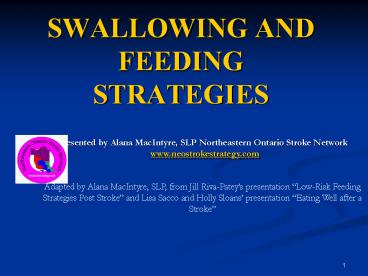SWALLOWING AND FEEDING STRATEGIES - PowerPoint PPT Presentation
1 / 34
Title:
SWALLOWING AND FEEDING STRATEGIES
Description:
Nectar Thick: This is the consistency of tomato juice or buttermilk. ... Eye-level with the patient. Across from the patient. Feeder should be comfortable ... – PowerPoint PPT presentation
Number of Views:74
Avg rating:3.0/5.0
Title: SWALLOWING AND FEEDING STRATEGIES
1
SWALLOWING AND FEEDING STRATEGIES
Presented by Alana MacIntyre, SLP Northeastern
Ontario Stroke Network www.neostrokestrategy.com
Adapted by Alana MacIntyre, SLP, from Jill
Riva-Pateys presentation Low-Risk Feeding
Strategies Post Stroke and Lisa Sacco and Holly
Sloans presentation Eating Well after a Stroke
2
The Importance of G
- Dysphasia/Aphasia - is a language disorder in
which there is an impairment of the comprehension
and expression of language - Dysphagia - is a medical term defined as
"difficulty swallowing."
3
Swallowing After Stroke
- Stroke can affect ability to eat or swallow when
- Muscles involved in feeding, swallowing, or
breathing are affected - Alertness and attention to eating are affected
- Independence for eating is taken away
4
Dysphagia
- Inability to safely swallow specific
consistencies of fluid and/or food - Presentation is varied and difficulty can occur
in one or more of the swallowing phases - Risk increases with the elderly population
5
Incidence of Dysphagia in Stroke
- 30-51 of stroke patients present with dysphagia
- 15-27 at 7 days
- 2-21 at 1 month
- 8 at 3 months
-
(Martino, 2000 Kidd,
1995)
6
Signs of Swallowing Problems?
- Drooling
- Slow eating, prolonged chewing
- Food left in mouth after eating
7
More Signs of Swallowing Problems?
- Coughing or choking during and/or after
swallowing - Throat clearing after swallowing
- Voice changes (i.e. wet/gurgly voice)
8
Complications
- Airway obstruction
- Aspiration pneumonia
- Malnutrition
- Dehydration
- Reduced quality of life
9
Palate
Velum
Tongue
Lips
Teeth
Pharynx
Valleculae
Epiglottis
Mandible
Hyoid
Larynx
Sulcus Cheek Salivary Glands
Esophagus
Trachea
10
Normal Swallow
- A semi-automatic motor action
- Movement of food from mouth to stomach
- Average adult swallows 1500 times per day
- Awake, we swallow once every 60-120 seconds
11
(No Transcript)
12
Normal Swallow
- Swallow has three phases
- Oral Phase
- Pharyngeal Phase
- Esophageal Phase
(xo.typepad.com/blog/ images/swordswallowing.jpg)
13
Oral Phase
- Initial Stage
- Food and drink are brought to the mouth
- Lips and jaw close to seal the mouth
- Saliva is produced to add moisture
14
- Oral Stage
- Under voluntary control
- Food is chewed and mixed with saliva to form a
bolus (ball of food) - Bolus is delivered by voluntary tongue movement
to the back of the mouth, into the pharynx
15
(No Transcript)
16
Pharyngeal Phase
- Involuntary/reflexive lasts 800 milliseconds
- Triggered when food passes towards the oesophagus
and the soft palate closes - Pharynx and the larynx move up to protect the
airway and direct the bolusto the oesophagus
17
(No Transcript)
18
Oesophageal Phase
- Involuntary/reflexive
- Relaxation of the upper part of the oesophagus
- Peristalsis pushes the bolus down into the
stomach - Gravity also assists with bolus transportation
19
(No Transcript)
20
Palate
Velum
Tongue
Lips
Teeth
Pharynx
Valleculae
Epiglottis
Mandible
Hyoid
Larynx
Sulcus Cheek Salivary Glands
Esophagus
Trachea
21
A Few Words About Reflexes
- Absence of a gag reflex does not predict
dysphagia - Presence of a gag reflex does not protect against
aspiration - The cough reflex can be impaired or absent, so
silent aspiration may occur
22
What Is Aspiration?
- Aspiration Inhaling of bacteria in saliva, food,
fluid or refluxed material into the airway - It can lead to choking, breathing problems or
aspiration pneumonia
23
- Dysphagia management is the key to preventing
aspiration!
24
Goals of Dysphagia Management
- Maximize nutrition
- Protect airway from obstruction
- Protect airway from aspiration
- Reflux
- Oral bacteria
- Medication
- Food
- Fluid
25
A Few Words About Feeding
- Stroke survivors should be encouraged and
assisted to feed themselves - safer than being
fed - 20 of patients who are fed develop Dysphagia -
movement of food from plate to mouth prepares for
swallowing - Use hand-over-hand support with Dysphagic
patients who cannot self-feed
26
Feeding Strategies
- Feeding is a skill that requires knowledge and
experience!!
27
Solid Textures
- Regular Any food
- Diced Food that is cut into bite-size pieces
- Minced Food that is the consistency of ground
meat (incl. scrambled eggs, and - salad sandwiches)
- Purée Food that has been blended
28
Fluid Textures
- Thin Any fluid, includes anything that turns
into a fluid once in the mouth (i.e.. ice cream,
Jell-o, milkshakes, etc.) - Nectar Thick This is the consistency of tomato
juice or buttermilk. - Honey Thick This is the thickest consistency,
almost the consistency of liquid honey
29
Diet Texture
- Solids
- Easiest-----------------------------------Hardest
- Puree Minced Diced Regular
- Fluids
- Easiest ----------------------------------Hardest
- Honey Nectar Thin
30
How Should the Person Be Positioned?
- While Eating and Drinking
- Sit fully upright
- Slight chin tuck
31
How Should the Feeder Be Positioned?
- Eye-level with the patient
- Across from the patient
- Feeder should be comfortable
- Do not feed from above the mouth
32
Other Feeding Strategies
- Feed at a relaxed pace
- Watch/feel for the swallow before giving the next
bite - One teaspoon at a time
- Do not engage in conversation during feeding
33
Other Feeding Strategies
- Remain upright for at least 30 minutes after meal
- Provide 1 pill at a time (crush if necessary)
- Complete mouth care after each meal
34
Refer to SLP If Patient Continues to Present With
- Coughing
- Choking
- History of pneumonia
- Temperature spikes
- Wet vocal quality
- Decreased lung sounds
- Malnutrition
- Dehydration

